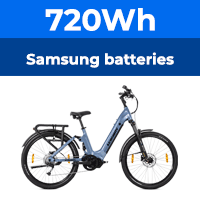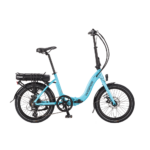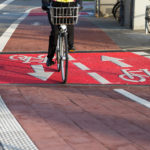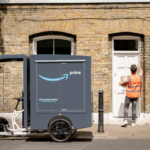I went to Marlborough last Friday to collect my Nano kit from Tony Castles and Simon Mills for my titanium M2L Brompton. They fitted it as well.
My reason for opting for this solution was that I have to travel c 2 miles to the station (no bus route or parking) to catch a train to London where I have another c 1.5 miles which isnt well served by public transport. All walkable or cycleable with a non electric Brompton I know, but I arrive a little more moist (OK more than a little) at the other end than I would like which isnt much fun in a suit with meetings to go to as soon as you arrive.
Weight (mine and the bike's) has therefore been a key issue and what led me to buying the titanium Brompton. I have therefore weighed the bike (using 2 accurate digital scales) at all stages of this project.
The bike as delivered with just the Brompton battery rear light as an extra weighed 10.38 kg
After removing the titanium forks and adding the nano motor, new widened steel front forks, wiring, throttle, control box, control box casing and a modified Brompton luggage block the bike now tips the scales at 13.77 kg - an increase of c 3.39kg. The weight gain wouldnt be quite so significant on a steel forked bike.
The battery weighs more than advertised and comes in at 3.21 kgs in it's case as supplied by Tony Castles. The Nano-motor website says 2.7kg. To this can be added the weight of the battery locating board to fit the Brompton Cloth pannier bag/frame giving a total battery/bag weight of 4.51kgs including shoulder strap.
Carrying 13.77 kgs in one hand and 4.51 kgs over the opposite shoulder is actually relatively easy for short distances, however the bike is heavier than I had hoped for and only marginally lighter than A to B claimed for a standard steel Nano modified Brompton L3. Their estimate of 12.8 kgs for a titanium bike is wide of the mark. This is however only just shy of 1kg heavier than a standard 6 speed brompton with rear rack.
The weight saving has been very expensive and has effetcively cost the best part of £400 to save around a kg. I may sell the titanium forks to recover some of this.
Whilst a little dissapointed with the weight I am otherwise really pleased with the bike. It is virtually silent in operation and hasnt suffered any or the quirkiness ("3 little clicks followed by a rattle") at startup described by A to B in their review. You can power off the line quite easily and pedalling appears to be completely optional - even up hills. Naturally I am intending to pedal more than is actually required. Honest!
As my daily round trip is only c 7 miles I will investigate some lighter batttery options which I believe will bring the total bike/bag/battery combination down from 18.28 kgs now, to around 16.1kgs - although I would prefer to save the weight on the bike not in the bag.
It is worth noting that Tony & Simon seem to have developed the kit a little and the wiring is now very tidy and quite minimal. They hope to make further imrpovements in this area. Some of the 'bulk', especially around the control box, is caused by the really quite large waterproof connectors they use. A notable improvement from the original conversion seems to be a watertight connector near the front hub so pucture repairs will be as easy as they are on a standard Brompton. This is actually much better than the junction box that the Schwinn Transit uses on it's Tongxin front hub powered bike.
I know many consider such bikes to be 'Bitsa's' however I believe this is a really well considered collection of parts that produce a very practical and competent folding bike, certainly much more practical than the Quando I have just sold. The Quando is a good bike but totaly unsuited to commuting on the train.
I will post a full review once I have lived with the bike on an everyday basis and hopefully will be able to post some pictures (if I can work out how).
Francis
My reason for opting for this solution was that I have to travel c 2 miles to the station (no bus route or parking) to catch a train to London where I have another c 1.5 miles which isnt well served by public transport. All walkable or cycleable with a non electric Brompton I know, but I arrive a little more moist (OK more than a little) at the other end than I would like which isnt much fun in a suit with meetings to go to as soon as you arrive.
Weight (mine and the bike's) has therefore been a key issue and what led me to buying the titanium Brompton. I have therefore weighed the bike (using 2 accurate digital scales) at all stages of this project.
The bike as delivered with just the Brompton battery rear light as an extra weighed 10.38 kg
After removing the titanium forks and adding the nano motor, new widened steel front forks, wiring, throttle, control box, control box casing and a modified Brompton luggage block the bike now tips the scales at 13.77 kg - an increase of c 3.39kg. The weight gain wouldnt be quite so significant on a steel forked bike.
The battery weighs more than advertised and comes in at 3.21 kgs in it's case as supplied by Tony Castles. The Nano-motor website says 2.7kg. To this can be added the weight of the battery locating board to fit the Brompton Cloth pannier bag/frame giving a total battery/bag weight of 4.51kgs including shoulder strap.
Carrying 13.77 kgs in one hand and 4.51 kgs over the opposite shoulder is actually relatively easy for short distances, however the bike is heavier than I had hoped for and only marginally lighter than A to B claimed for a standard steel Nano modified Brompton L3. Their estimate of 12.8 kgs for a titanium bike is wide of the mark. This is however only just shy of 1kg heavier than a standard 6 speed brompton with rear rack.
The weight saving has been very expensive and has effetcively cost the best part of £400 to save around a kg. I may sell the titanium forks to recover some of this.
Whilst a little dissapointed with the weight I am otherwise really pleased with the bike. It is virtually silent in operation and hasnt suffered any or the quirkiness ("3 little clicks followed by a rattle") at startup described by A to B in their review. You can power off the line quite easily and pedalling appears to be completely optional - even up hills. Naturally I am intending to pedal more than is actually required. Honest!
As my daily round trip is only c 7 miles I will investigate some lighter batttery options which I believe will bring the total bike/bag/battery combination down from 18.28 kgs now, to around 16.1kgs - although I would prefer to save the weight on the bike not in the bag.
It is worth noting that Tony & Simon seem to have developed the kit a little and the wiring is now very tidy and quite minimal. They hope to make further imrpovements in this area. Some of the 'bulk', especially around the control box, is caused by the really quite large waterproof connectors they use. A notable improvement from the original conversion seems to be a watertight connector near the front hub so pucture repairs will be as easy as they are on a standard Brompton. This is actually much better than the junction box that the Schwinn Transit uses on it's Tongxin front hub powered bike.
I know many consider such bikes to be 'Bitsa's' however I believe this is a really well considered collection of parts that produce a very practical and competent folding bike, certainly much more practical than the Quando I have just sold. The Quando is a good bike but totaly unsuited to commuting on the train.
I will post a full review once I have lived with the bike on an everyday basis and hopefully will be able to post some pictures (if I can work out how).
Francis







